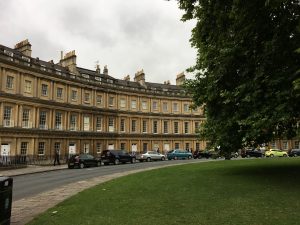Another day in the SW of England, but time to move on to a new locale, for new experiences and views and places to explore. Lucy had arranged for a day in Bath, so we set off by 10:30 for the 2 hour drive through the Hampshire and Somerset countryside to this lovely city. It continued to be dreary and chilly, but the rolling hills, wheat fields, deep greens and charming villages along the way made for a lovely drive. We met Lucy’s son Sam, who I haven’t seen in 20 years for lunch — it was quite a treat to see the little boy all grown up. (In Winchester I was also pleased to have seen Rebecca, Liz’s bestie from 2nd and 3rd grade)!
Bath is set in the River Avon valley and is the largest city in the county. Known for the Roman Baths, it is set on the steep hillsides on either side of the city center and river. The Georgian architecture of many of the buildings is well-preserved, and the little streets continue to have the charm that so attracted many historical figures to live and write about Bath. The creamy gold stone used in many of the buildings, which seem to have identical facades, give the impression of palatial scale and classic decorum. The Circus is divided into three segments of equal length, is a circular space surrounded by large townhouses. Each of the curved segments faces one of the three entrances, ensuring that whichever way a visitor enters there is a classical facade straight ahead. The architect, convinced that Bath had been the principal centre of Druid activity in Britain, surveyed Stonehenge and used the same dimensions (318 feet) for The Circus’ diameter and was completed in the late 18thC. The Royal Crescent is a similar example of fine Georgian architecture, with 30 townhouses built into a semi-circle facing a large green space. It is quite imposing and just one of several crescents in the city, most designed by the same architect and completed while England was at war with the newly formed American states!
The highlight of the city are the Roman Baths, which are dated with certainty to the Roman times, but are believed to have been in use before that. The earliest inscription dates from 76AD, when the city was known as Aquae Sulis. The natural hot spring became the center of town, with extensive baths being fed by what was believed to be a sacred spring. An important temple was built at the site too, in celebration of the Goddess Minerva. The spring continues to pump over 1 million liters of water each date at a steady 115 degrees F. There were saunas and baths and cold plunge pools in the massive space, and the museum on the grounds now is wonderful at describing life in the days of the first use of the hot springs.
The current Bath Abbey was build in 1499, dissolved by Henry VIII in 1539 and then repaired in the 17th C. The fan vaulted ceiling was created in the 1500’s by the kings master masons, in order to draw us up to God. The Great East Window was largely destroyed in the 1940’s wartime bombings and blitz, but the much of the leaded glass was saved and over 60% of the re-built window is original glass. There was a choir practicing for a chorale in the evening, so I was treated to lovely music as I strolled through the beautiful building.
We are staying at the house of a friend of Lucy in a huge Georgian home built into one of the hillsides overlooking the city. Quite impressive, and the stairs that took us to and from dinner down below reminded me of Silver Lake.
That was Friday and a wonderful day it was indeed.




















Bath’s awesome – went there on my way to Stonehenge. We’ll have to compare piccies.